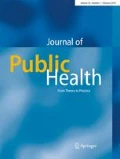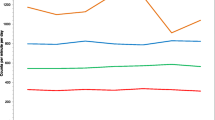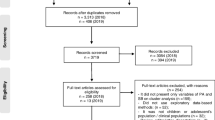Abstract
Aim
The aim of the current study was to examine the physical activity and sedentary behavioral patterns of children and adolescents using the model-based latent profile analysis (LPA) approach.
Subject and methods
A sample of 847 school children aged 10 to 16 years from 28 Singapore schools took part in the study. Physical activity and sedentary behavior were assessed using a 7-day physical activity recall questionnaire.
Results
The findings of the present study showed that there were at least five groups of students with unique sedentary and physical activity patterns. A few clusters were gender-specific. For example, groups 1 and 4 were female-dominated clusters and group 3 was male-dominated. The younger children in the primary school had different sedentary and physical activity behaviors.
Conclusions
This study demonstrates the use of LPA to group individuals into homogenous groupings in order to help researchers make informed decisions about the number of underlying groupings. This can have benefits for targeting specific groups in interventions.

Similar content being viewed by others
References
Akaike H (1987) Factor analysis and the AIC. Psychometrika 52:317–332
Berger BG, Owen DR (1992) Mood alteration with yoga and swimming: aerobic exercise may not be necessary. Percept Mot Skills 75:1331–1343
Biddle S, Sallis J, Cavill N (eds) (1998) Young and active? Young people and health-enhancing physical activity: evidence and implications. Health Education Authority, London
Biddle SJH, Fox KR, Boutcher SH (eds) (2000) Physical activity and psychological well-being. Routledge, London
Blair SN, Kohl HW, Gordon NF, Paffenbarger RS (1992) How much physical activity is good for health? Ann Rev Public Health 99:99–126
Caspersen CJ, Powell KE, Christenson GM (1985) Physical activity, exercise, and physical fitness: definitions and distinctions for health-related research. Public Health Rep 100(2):126–131
Department of Statistics S (2009) Yearbook of statistics Singapore. Ministry of Trade and Industry, Singapore
Dietz WH (1996) The role of lifestyle in health: the epidemiology and consequences of inactivity. Proc Nutr Soc 55:829–840
Gorely T, Marshall SJ, Biddle SJH, Cameron N (2007) The prevalence of leisure time sedentary behaviour and physical activity in adolescent girls: an ecological momentary assessment approach. Int J Pediatr Obes 2(4):227–234
Hair JFJ, Anderson RE, Tatham RL, Black WC (1998) Multivariate data analysis, 5th edn. Prentice-Hall, Englewood Cliffs, NJ
Hamilton MT, Healy GN, Dunstan DW, Zderic TW, Owen N (2008) Too little exercise and too much sitting: inactivity physiology and the need for new recommendations on sedentary behavior. Current Cardiov Risk Rep 2:292–298
Kemper HCG, Post GB, Twisk JWR, van Mechelen W (1999) Lifestyle and obesity in adolescence and young adulthood: results from the Amsterdam growth and health longitudinal study (AGAHLS). Int J Obes 23(Suppl 3):34–40
Lo Y, Mendell NR, Rubin DB (2001) Testing the number of components in a normal mixture. Biometrika 88:767–778
Marsh HW, Lȕdtke O, Trautwein U, Morin JSA (2009) Classical latent profile analysis of academic self-concept dimensions: synergy of person- and variable-centered approaches to theoretical models of self-concept. Struct Equ Modeling 16:191–225. doi:10.1080\10705510902751010
Marshall SJ, Biddle SJH, Sallis JF, Mckenzie TL, Conway TL (2002) Clustering of sedentary behaviors and physical activity among youth: a cross-national study. Pediatr Exerc Sci 14:401–417
Marshall SJ, Gorely T, Biddle SJH (2006) A descriptive epidemiology of screen-based media use in youth: a review and critique. J Adolesc 29(3):333–349. doi:10.1016/j.adolescence.2005.08.016
Meece JL, Holt K (1993) A pattern analysis of students’ achievement goals. J Educ Psychol 85(4):582–590. doi:10.1037/0022-0663.85.4.582
Muthén B (2001) Latent variable mixture modeling. In: Marcoulides GA, Schumacker RE (eds) New developments and techniques in structural equation modeling. Lawrence Erlbaum, Magwah, NJ, pp 1–33
Muthén LK, Muthén BO (2004) MPlus: version 4.2. Muthén and Muthén, Los Angeles
Owen N, Bauman A, Brown W (2009) Too much sitting: a novel and important predictor of chronic disease risk? Br J Sports Med 43:81–83
Pastor DA, Barron KE, Miller BJ, Davis SL (2007) A latent profile analysis of college students’ achievement goal orientation. Contemp Educ Psychol 32:8–47. doi:10.1016/j.cedpsych.2006.10.003
Pate RR, Trost SG, Dowda M, Ott AE, Ward DS, Saunders R, Felton G (1999) Tracking of physical activity, physical inactivity, and health-related physical fitness in rural youth. Pediatr Exerc Sci 11:364–376
Ridley K, Ainsworth B, Olds T (2008) Development of a compendium of energy expenditures for youth. Int J Behav Nutr Phys Act 5:45
Sallis JF (1994) Influences on physical activity of children, adolescents, and adults on determinants of active living. Res Digest Series 1, President’s Council for Phys Fitness and Sports Phys Activity and Fitness, Washington, DC, pp 1–8
Sallis JF, Owen N (1999) Physical activity and behavioural medicine. Sage, Thousands Oaks, CA
Sallis JF, Saelens BE (2000) Assessment of physical activity by self-report: status, limitations, and future directions. Res Q Exerc Sport 71:S1–S14
Sallis JF, Strikmiller PK, Harsha D, Feldman HA (1996) Validation of interviewer- and self-administered physical activity checklists for fifth grade students. Med Sci Sports Exerc 28:840–851
Schwartz G (1978) Estimating the dimension of a model. Ann Stat 6:461–464
Stensel DJ, Gorely T, Biddle SJH (2008) Youth health outcomes. In: Smith AL, Biddle SJH (eds) Youth physical activity and sedentary behavior: challenges and solutions. Human Kinetics, Champaign, IL, pp 31–57
Tremblay MS (2010) Assessing the level of sedentarism. In: Bouchard C, Katzmarzyk PT (eds) Physical activity and obesity, 2nd edn. Human Kinetics, Champaign, IL, pp 13–17
Vermunt JK, Magidson J (2002) Latent class cluster analysis. In: Hagenaars JA, McCutcheon AL (eds) Applied latent class analysis. Cambridge University Press, Cambridge, UK, pp 89–106
Wang CKJ, Biddle SJH (2001) Young people’s motivational profiles in physical activity: a cluster analysis. J Sport Exerc Psychol 23:1–22
Wang CKJ, Chia M, Quek JJ, Liu WC (2006) Patterns of physical activity, sedentary behaviours and psychological determinants among Singaporean school children. Int J Sport Exerc Psychol 4:227–249
Williams CL (1994) Coronary heart disease prevention in childhood, part 1: background and rationale. Med Exerc Nutr Health 3:194–205
Acknowledgements
This research was made possible by funding obtained from the Ministry of Education (Singapore) Education Research Fund (EP 2/06 JW). The authors would also like to thank the reviewers of this article for their effort and insightful comments.
Conflict of interest
The authors declare no conflict of interest.
Author information
Authors and Affiliations
Corresponding author
Rights and permissions
About this article
Cite this article
Wang, C.K.J., Biddle, S.J.H., Liu, W.C. et al. A latent profile analysis of sedentary and physical activity patterns. J Public Health 20, 367–373 (2012). https://doi.org/10.1007/s10389-011-0464-9
Received:
Accepted:
Published:
Issue Date:
DOI: https://doi.org/10.1007/s10389-011-0464-9




